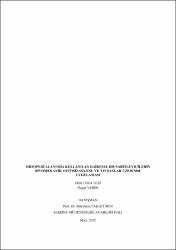Ortopedi alanında kullanılan dairesel dış sabitleyicilerin biyomekanik optimizasyonu ve tavşanlar üzerinde uygulaması
Özet
Bu araştırmanın amacı ortopedi alanında kullanılan dış sabitleyicilerden birisi olan yeni tasarlanmış Dairesel eksternal fiksatör (DEF) sisteminin biyomekanik optimizasyonunun gerçekleştirilmesi ve kırık hattı üzerindeki baskı miktarı değişiminin kırık iyileşmesi üzerine etkisinin incelenmesidir. Dış sabitleyiciler, hasarlı uzuvların stabilizasyonunu sağlayan vücut dışından uygulanan bir cihaz ile iskelet deformitelerinin düzeltilmesinin yanı sıra kemik ve eklem hasarlarının tedavisinde kullanılan bir yöntem olarak görülmektedir. Çalışma nümerik ve klinik olmak üzere iki aşamada gerçekleştirilmiştir. Nümerik çalışmada, DEF sistemi üzerinde belirlenen parametrelerin göz önüne alınarak değişimlerinin sistem ve kırık hattı üzerindeki etkileri sonlu elemanlar metodunu kullanan ANSYS yazılımı ile incelenmiştir. Klinik çalışmada ise yeni tasarlanan ve üretilen DEF sistemi 36 adet Yeni Zelanda cinsi Albino tavşan tibia üzerine monte edilmiş ve belirli sürelerde radyolojik ve histolojik analizler ile incelenmiştir. Bu çalışmada, nümerik analizlerin doğruluğunun tespit edilebilmesi için konvansiyonel sistemin kullanıldığı kontrol grubu ve sonlu elemanlar çözümlerinden elde edilen iki farklı deney grubu olmak üzere üç farklı DEF sistem grubu üzerinde incelemeler yapılmıştır. Geliştirilen yeni sistemin hem erken dönem hemde geç dönem kırık iyileşmesinin konvansiyonel sisteme göre daha avantajlı olduğu görülmüştür. The aim of this study is to perform biomechanical optimization of the newly designed CEF used in the field of orthopaedics. With this optimized design, the change of amount of pressure on fracture line is examined the effects on the fracture healing. External fixators provide the correction of skeletal deformities with a device applied from outside the body. Therefore they are regarded as a method used in the treatment of bone and joint damages. The study was performed in two phases: numerical and clinical. The changes of the determined parameters on the CEF system were considered and their influences on the system and fracture line were investigated using ANSYS software. In clinical study, designed and manufactured CEF system was mounted on the tibia of 36 New Zealand white rabbits and radiological and histological analysis performed at certain periods. This study has been conducted on three different designs including the control group in which the conventional system is used and two experimental groups obtained from the finite element solutions in order to determine the accuracy of the numerical analysis. Consequently, fracture healing of both early and late period of developed the new system was found to be more advantageous than the conventional system
Bağlantı
http://hdl.handle.net/11630/6018Koleksiyonlar
- Yüksek Lisans Tezleri [879]



















